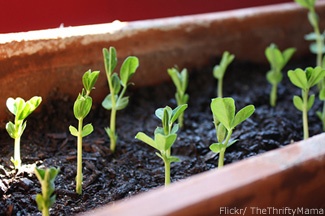We have much more to do and your continued support is needed now more than ever.
Go Green with a St. Patrick’s Day Garden
Guest post by Elizabeth Scholl
 In Ireland, St. Patrick’s Day is the traditional day to plant peas and potatoes. The timing works for most climates in the United States, so why not celebrate St. Patrick’s Day with a really “green” activity: planting a garden!
In Ireland, St. Patrick’s Day is the traditional day to plant peas and potatoes. The timing works for most climates in the United States, so why not celebrate St. Patrick’s Day with a really “green” activity: planting a garden!
Depending on where you live, you may find your garden bed is still covered with snow or the soil too frozen to work. Or your home may not have a backyard. Luckily, peas and potatoes can be planted in containers, and you can enjoy the harvest on a deck, balcony, or sunny windowsill. Then you can decorate it with a shamrock plant marker!
What You Need:
- good quality potting soil
- large flower pot with saucer (Note: Make sure the pot has drainage holes in the bottom and is at least 15 inches in diameter at the top.)
- pea seeds and seed potatoes (Note: Don’t plant potatoes from the supermarket. They may be sprayed with chemicals and won’t grow well. You can buy them at a local gardening store.)
- thin branches to use as support for vines
- water
What You Do:
1. Fill your container two-thirds full with potting soil.
2. Press your pea seeds or seed potatoes into the dirt. Cover with an inch or two of soil.
3. Stick long, thin branches upright in the soil. As the vines grow, they will wrap themselves around the branches.
4. Put containers in a sunny indoor spot or outdoors in full or partial sunlight. If frost is forecast, bring containers indoors.
5. Water every two to three days, keeping moist. Be careful not to over-water.
6. For potato plants:
- As your potato plant grows, add more soil around the base of the plant, making a little hill. In fact, this is called hilling. Hilling should be done every time your plant grows about four inches.
- Continue to water the plant regularly as leaves and then flowers grow. When the leaves of the potato plants begin to turn yellow and die, stop watering.
- After two or three weeks, baby potatoes will be ready to harvest, or you can wait another four to six weeks to harvest larger potatoes.
7. For pea plants: Peas are ready to pick when the pods are full and heavy. Use scissors to cut the pods from the plant. Pulling them off by hand can result in pulling the entire plant up and damaging the roots.
Growing Tips:
- In areas of the United States that are too warm in March to plant cool-weather peas and potatoes, you can plant sweet potatoes, beans, and leafy greens such as spinach or swiss chard.
- Some gardeners sprout seed potatoes before planting, so they begin growing more quickly—a practice known as chitting. Put your seed potatoes on a shallow dish or tray, or in an open egg carton. Keep them in a warm place with a lot of sunlight or under a fluorescent light. When the potatoes have one-inch sprouts, they are ready to plant.
- When watering the pea plants, be careful not to get water on the leaves of the plant. Water can cause mildew to grow on the leaves.
Make a Shamrock Plant Marker
Make a festive shamrock plant marker to decorate your containers and to remind you what you have planted.
What You Need:
- popsicle stick, chopstick, or pencil
- green paper, or white paper and a green marker or crayon
- tape or glue
- black permanent marker
What You Do:
1. Trace and cut three small hearts from paper. If your paper is white, color your hearts green.
2. Tape or glue the three hearts together to form a shamrock.
3. Write “Peas” or “Potatoes” on your shamrock, depending on the container it will go into.
4. Tape or glue your shamrock to your stick or pencil.
5. Put the marker into the soil of the container.
Did you know? Gardening–even vegetable gardening–offers us a gateway into the natural world. In just a few easy steps, you can turn your any yard or garden space into a habitat for birds, butterflies, bees and other wildlife. Learn how to Create a Wildlife Habitat Garden!
Now available: Garden and Herb Nature Guide! Whether you’re gardening for food, for beauty or to support your local wildlife, the National Wildlife Federation’s Garden Guide app series will help you do all this and more. Download the app here.
Elizabeth Scholl is a New Jersey-based writer of children’s books and magazine articles, with a background in elementary education. Specializing in nature and environmental topics, her books includeOrganic Gardening for Kids, Grasshopper, Praying Mantis and Animals Attack: Wolves. When she isn’t writing, Elizabeth enjoys working in her garden, bicycling and and exploring nature in her neighborhood.





















